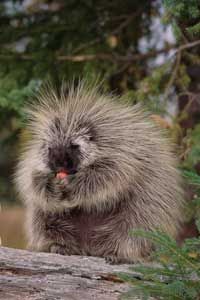Quck answer
If you or your pet have been quilled by a porcupine, it’s important to remove the quills as soon as possible to prevent infection. The best way to do this is to use pliers or tweezers to grasp the base of the quill and pull it out firmly and quickly in the opposite direction it entered. If the quills are deeply embedded or there are too many to remove on your own, seek veterinary or medical attention. Avoid cutting the quills or attempting to push them further into the skin, as this can cause more damage and make removal more difficult.
Wild Animals

If you want to pet a porcupine, you’ll have to watch out for their 30,000 quills. These prickly hairs cover their entire bodies, except for their faces, inner limbs, and bellies. Porcupines use their quills as a defensive mechanism to protect themselves from predators. They may rustle their quills to warn potential predators to back off. If the threat continues to advance, the predator may end up with a face full of barbed hairs. Porcupines do not use their quills for hunting since they are herbivores, eating mostly inner tree bark and foliage. Porcupine quills serve as part of the animal’s warning system and are marked with white pigmentation that contrasts with the porcupine’s darker fur, making them more visible to any potentially threatening animals at night. Additionally, when the rodent becomes perturbed, the quills atop the rosette emit a pungent hormonal odor. Porcupines have thousands of quills that lay flat when the animal is relaxed and stand on end when it feels threatened. Quills vary in size from half an inch to 4 inches long. Quills are really specialized hairs that consist of a follicle that attaches to the skin, a shaft with a spongy interior, and the notorious barbed tip. If you look closely at the tip, you’ll see multiple layers of barbs that cause the quill to embed deeper into a victim’s skin after penetration. However, sometimes, porcupines can fall prey to their own defensive tricks. If you need to remove porcupine quills, it is best to seek professional help as it can be a painful and delicate process that requires specialized techniques.
FAQ
1. How do I know if my pet has porcupine quills?
If your pet has been in contact with a porcupine, you may notice quills sticking out of their skin. Signs of porcupine quill injury may include limping, swelling, and pain. It is important to seek veterinary care if you suspect your pet has porcupine quills.
2. Can I remove porcupine quills myself?
It is not recommended to remove porcupine quills yourself, as this can cause the quills to break and become embedded deeper into the skin. It is best to seek veterinary care for proper removal of porcupine quills.
3. What should I do if my pet has porcupine quills?
If your pet has porcupine quills, it is important to seek veterinary care as soon as possible. Your veterinarian will sedate your pet and remove the quills using special tools to prevent further injury.
4. Can porcupine quills cause infections?
Yes, porcupine quills can cause infections if they are not promptly removed. The quills can introduce bacteria into the skin, leading to inflammation and infection. It is important to seek veterinary care if your pet has porcupine quills.
5. Can porcupine quills be deadly?
While porcupine quills are not typically deadly, they can cause serious injury if left untreated. Quills that are not promptly removed can migrate deeper into the skin, causing infection and other complications. Seek veterinary care if your pet has porcupine quills.
6. How long does it take for a porcupine quill to work its way out?
Porcupine quills can take several weeks to work their way out of the skin, depending on how deeply they are embedded. It is important to seek veterinary care to prevent complications from quills that are not promptly removed.
7. Can I prevent my pet from getting porcupine quills?
You can reduce the risk of your pet getting porcupine quills by keeping them on a leash and avoiding areas where porcupines are known to live. If your pet does encounter a porcupine, it is important to seek veterinary care as soon as possible.
8. What are the complications of porcupine quill injuries?
Complications of porcupine quill injuries can include infection, migration of the quills deeper into the skin, and damage to internal organs if the quills are ingested. It is important to seek veterinary care if your pet has been injured by porcupine quills.
9. Can porcupine quills be prevented?
Porcupine quills cannot be prevented entirely, but you can reduce the risk of your pet getting quills by keeping them on a leash and avoiding areas where porcupines are known to live. If your pet does encounter a porcupine, seek veterinary care as soon as possible.
10. How much does it cost to remove porcupine quills?
The cost of removing porcupine quills varies depending on the severity of the injury and the location of the veterinary clinic. It is best to contact your local veterinarian for an estimate of the cost of removing porcupine quills.





Leave a Reply